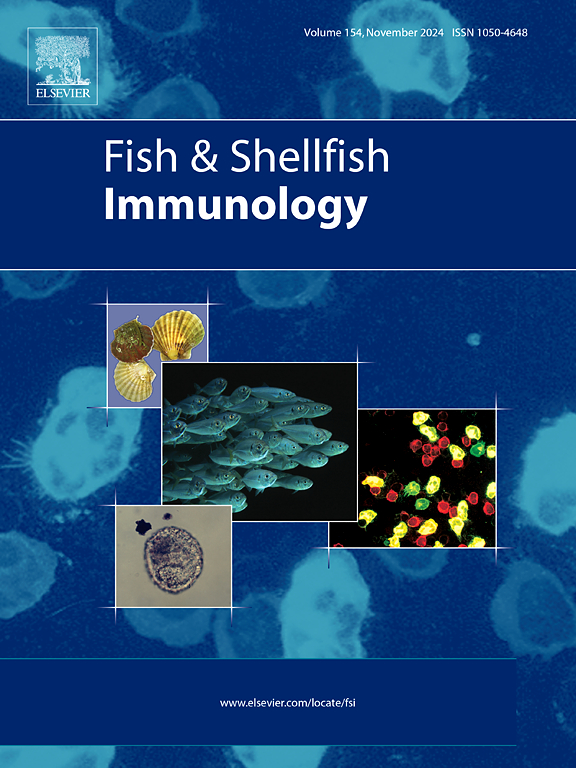凡纳滨对虾传染性皮下和造血坏死病毒相互作用蛋白的筛选
IF 3.9
2区 农林科学
Q1 FISHERIES
引用次数: 0
摘要
感染性皮下及造血坏死病毒(IHHNV)是严重影响对虾养殖业的主要病原体,并造成重大经济损失。了解虾对IHHNV感染的分子反应机制对于制定有效的疾病控制策略至关重要。为了深入探索凡纳滨对虾对IHHNV感染反应的分子机制,本研究通过酵母双杂交系统筛选与IHHNV相互作用的对虾蛋白。以IHHNV编码的衣壳蛋白(CP)、非结构蛋白1 (NS1)和非结构蛋白2 (NS2)分别作为诱饵蛋白,对酵母文库进行筛选。CP阳性克隆63个,NS1阳性克隆90个,NS2阳性克隆35个。去除重复基因后,分别获得14、14和11个阳性候选蛋白。随后,选取3、4、5个候选蛋白进行回交验证,脂肪酸结合蛋白1-B。1-like (fabp1 -b .1 like)、伸长因子2-like异构体X2 (EF2L-X2)和胰岛素样生长因子结合蛋白相关蛋白1 (IGFBP-rP1)与CP相互作用,甘油醛3-磷酸脱氢酶(GAPDH)、磷酸丙酮酸水解酶(PEP)和α-葡萄糖苷酶(α-Glu)与NS1相互作用。FABP1-B。1-like、α-Glu、输入蛋白亚基α- 1 (IMPα1)、40S核糖体蛋白s20样异构体X1 (RPS20-X1)和NPC细胞内胆固醇转运蛋白2-like (NPC2-like)与NS2相互作用。这些相互作用蛋白为分析IHHNV与宿主的相互作用以及揭示病毒感染调控的分子机制提供了重要的参考依据。本文章由计算机程序翻译,如有差异,请以英文原文为准。
Screening of proteins interacting with infectious hypodermal and hematopoietic necrosis virus in Pacific white shrimp Litopenaeus vannamei
Infectious hypodermal and hematopoietic necrosis virus (IHHNV) is a major pathogen that severely impacts the shrimp aquaculture industry, and has lead to significant economic losses. Understanding the molecular response mechanisms of shrimp against IHHNV infection is crucial for developing effective disease control strategies. In order to deeply explore the molecular mechanism of Litopenaeus vannamei responds to IHHNV infection, this study screened the shrimp proteins interacting with IHHNV via the yeast two-hybrid system. The proteins encoded by IHHNV, including the capsid protein (CP), non-structural protein 1 (NS1) and non-structural protein 2 (NS2), were used as bait proteins, respectively, to screen against yeast library. Totally 63, 90, and 35 positive clones were obtained for CP, NS1, and NS2, respectively. After removal of duplicate genes, 14, 14, and 11 positive candidate proteins were obtained, respectively. Subsequently, 3, 4, and 5 candidate proteins were selected for backcross verification, and fatty acid binding protein 1-B.1-like (FABP1-B.1-like), elongation factor 2-like isoform X2 (EF2L-X2), and insulin-like growth factor-binding protein-related protein 1 (IGFBP-rP1) interacted with CP. Glyceraldehyde 3-phosphate dehydrogenase (GAPDH), Phosphopyruvate hydrolase (PEP), and Alpha-glucosidase (α-Glu) interacted with NS1. FABP1-B.1-like, α-Glu, importin subunit alpha-1 (IMPα1), 40S ribosomal protein S20-like isoform X1 (RPS20-X1), and NPC intracellular cholesterol transporter 2-like (NPC2-like) interacted with NS2. These interacting proteins provide an important reference basis for analyzing the interactions between IHHNV and the host, as well as for revealing the molecular mechanisms regulating viral infection.
求助全文
通过发布文献求助,成功后即可免费获取论文全文。
去求助
来源期刊

Fish & shellfish immunology
农林科学-海洋与淡水生物学
CiteScore
7.50
自引率
19.10%
发文量
750
审稿时长
68 days
期刊介绍:
Fish and Shellfish Immunology rapidly publishes high-quality, peer-refereed contributions in the expanding fields of fish and shellfish immunology. It presents studies on the basic mechanisms of both the specific and non-specific defense systems, the cells, tissues, and humoral factors involved, their dependence on environmental and intrinsic factors, response to pathogens, response to vaccination, and applied studies on the development of specific vaccines for use in the aquaculture industry.
 求助内容:
求助内容: 应助结果提醒方式:
应助结果提醒方式:


